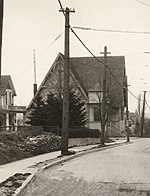Cambern Dutch Shop Windmill
1929 establishments in Washington (state)Buildings and structures in Spokane, WashingtonCommercial buildings completed in 1929Commercial buildings on the National Register of Historic Places in Washington (state)Location maps with marks outside map and outside parameter not set ... and 6 more
National Register of Historic Places in Spokane, WashingtonNovelty buildings in Washington (state)Washington (state) Registered Historic Place stubsWikipedia page with obscure subdivisionWindmills completed in 1929Windmills in the United States

Cambern Dutch Shop Windmill is a historic commercial building constructed in the shape of a windmill at 1102 S. Perry in Spokane, Washington, United States. It was built in 1929 and added to the National Register of Historic Places in 1989.The building is located in the South Perry District of the East Central neighborhood. It is located along Perry Street in a commercial district which serves the immediate and wider neighborhoods. As of 2022 the building is home to Lorien Herbs and Natural Foods.
Excerpt from the Wikipedia article Cambern Dutch Shop Windmill (License: CC BY-SA 3.0, Authors, Images).Cambern Dutch Shop Windmill
East 11th Avenue, Spokane
Geographical coordinates (GPS) Address Nearby Places Show on map
Geographical coordinates (GPS)
| Latitude | Longitude |
|---|---|
| N 47.645277777778 ° | E -117.38888888889 ° |
Address
Perry Street Brewing
East 11th Avenue
99202 Spokane
Washington, United States
Open on Google Maps






